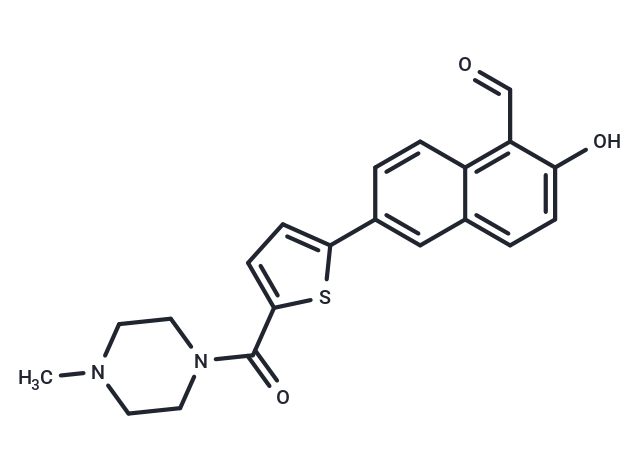Shopping Cart
- Remove All
 Your shopping cart is currently empty
Your shopping cart is currently empty


| Pack Size | Price | Availability | Quantity |
|---|---|---|---|
| 1 mg | $61 | In Stock | |
| 5 mg | $173 | In Stock | |
| 10 mg | $279 | In Stock | |
| 25 mg | $468 | In Stock | |
| 50 mg | $688 | In Stock | |
| 100 mg | $978 | In Stock | |
| 1 mL x 10 mM (in DMSO) | $159 | In Stock |
| Description | MKC3946 is an effective and soluble IRE1α inhibitor which triggered modest growth inhibition in multiple myeloma cell lines. |
| In vitro | MKC-3946 is an IRE1α endoribonuclease domain inhibitor that effectively obstructs the splicing of XBP1 mRNA, demonstrating cytotoxic effects against AML cells and a modest inhibition of growth in MM cells. The compound suppresses XBP1S expression induced by tunicamycin (TM) in NB4 cells and AML samples from patients, without affecting the phosphorylation of IRE1α. Additionally, it prevents the splicing of XBP1 mRNA in response to ER stress from mutant proinsulin production and enhances the cytotoxicity of therapies like bortezomib or 17-AAG by blocking XBP1 splicing. MKC-3946 at a concentration of 10μM amplifies ER stress-mediated apoptosis triggered by these agents and bolsters the cytotoxic effects of ER stressors, even in the presence of bone marrow stromal cells (BMSCs) or external IL-6. |
| In vivo | MKC-3946 (100 mg/kg, i.p.) inhibits XBP1 splicing in an in vivo ER stress model, significantly inhibiting MM cell growth alone or with bortezomib. This compound markedly reduces MM tumor growth compared to the control group, indicating that its inhibition of XBP1 splicing is associated with decreased MM growth in vivo, both alone and in combination with bortezomib [3]. |
| Cell Research | For each assay, the various numbers of cells (1,000 for cell proliferation and 10,000 for cell viability assays) are seeded in 96-well plates, followed by either vehicle (DMSO) or increasing concentrations of the drug. For detection of relative numbers of living cells, 10 μL of MTT (5 mg/mL) is added to each well, placed in an incubator for four hours, followed by centrifugation (1,000 rpm, 5 min); 100 μL of supernatant media from each well are carefully removed and 100 μL of SDS buffer (20% in water) is added to dissolve the crystals. Results are further read on the spectrophotometer machine at 570 nM wavelength. Half maximal inhibitory concentration (IC50) is calculated using the GraphPad Prism 5. A synergy of combination of two drugs is determined using the CalcuSyn software. The extent of drug interaction between the two drugs is determined using the combination index (CI) for mutually exclusive drugs. Different CI values are obtained when solving the equation for different concentrations of drugs. A CI of 1 indicates an additive effect, whereas a CI of <1denotes synergy. All experiments are repeated at least three times [1]. |
| Animal Research | CB17 SCID mice (48-54 days old) are injected subcutaneously with 1×10^7 RPMI 8226 cells mixed with Matrigel on day 0, and receive treatment for 21 days starting on day1. Mice are assigned into 4 groups (n=8): daily intraperitoneal injections of 100 mg/kg MKC-3946; intravenous injections of 0.15 mg/kg bortezomib twice a week; a combination of MKC-3946 intraperitoneally with bortezomib intravenously; and 10% HPBCD intraperitoneally with normal saline intravenously as vehicle control. Tumor volume is calculated from caliper measurements every 3 to 4 days; mice are killed when tumors reached 1.5 cm in length. Survival is evaluated from the first day of treatment until death [3]. |
| Molecular Weight | 380.46 |
| Formula | C21H20N2O3S |
| Cas No. | 1093119-54-0 |
| Storage | Powder: -20°C for 3 years | In solvent: -80°C for 1 year | Shipping with blue ice. | ||||||||||||||||||||||||||||||
| Solubility Information | DMSO: 30 mg/mL (78.85 mM) | ||||||||||||||||||||||||||||||
Solution Preparation Table | |||||||||||||||||||||||||||||||
DMSO
| |||||||||||||||||||||||||||||||

Copyright © 2015-2024 TargetMol Chemicals Inc. All Rights Reserved.